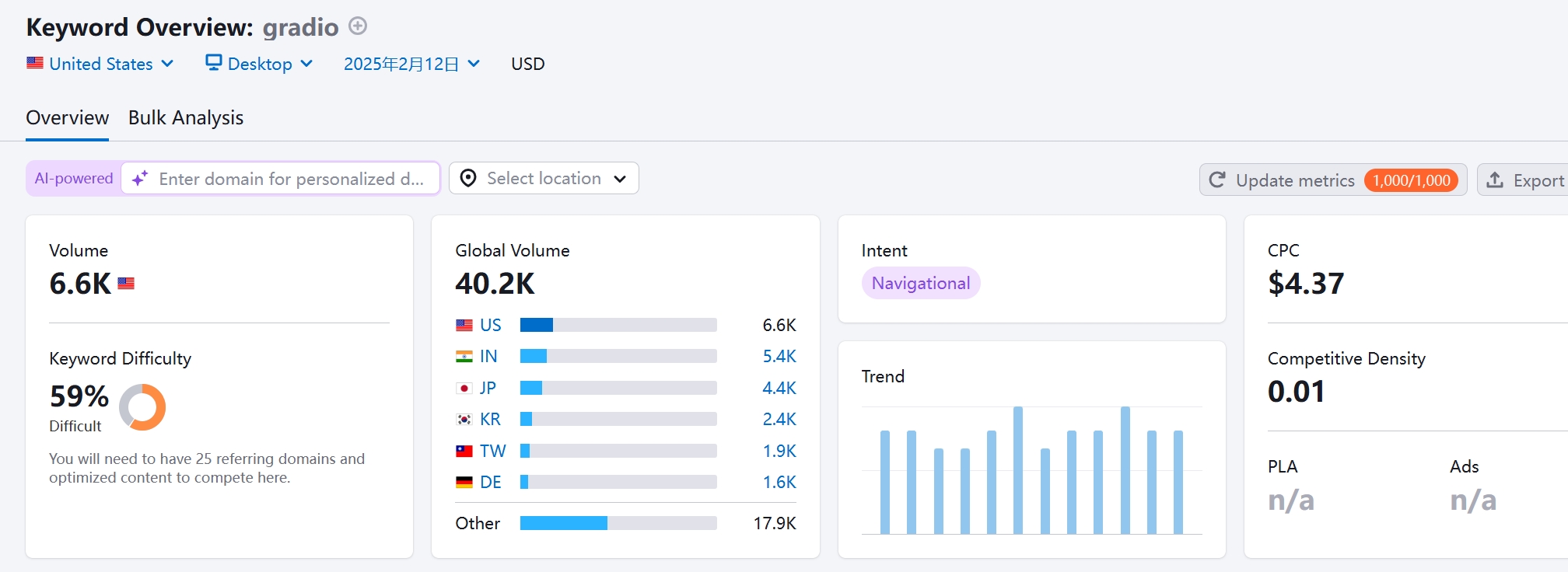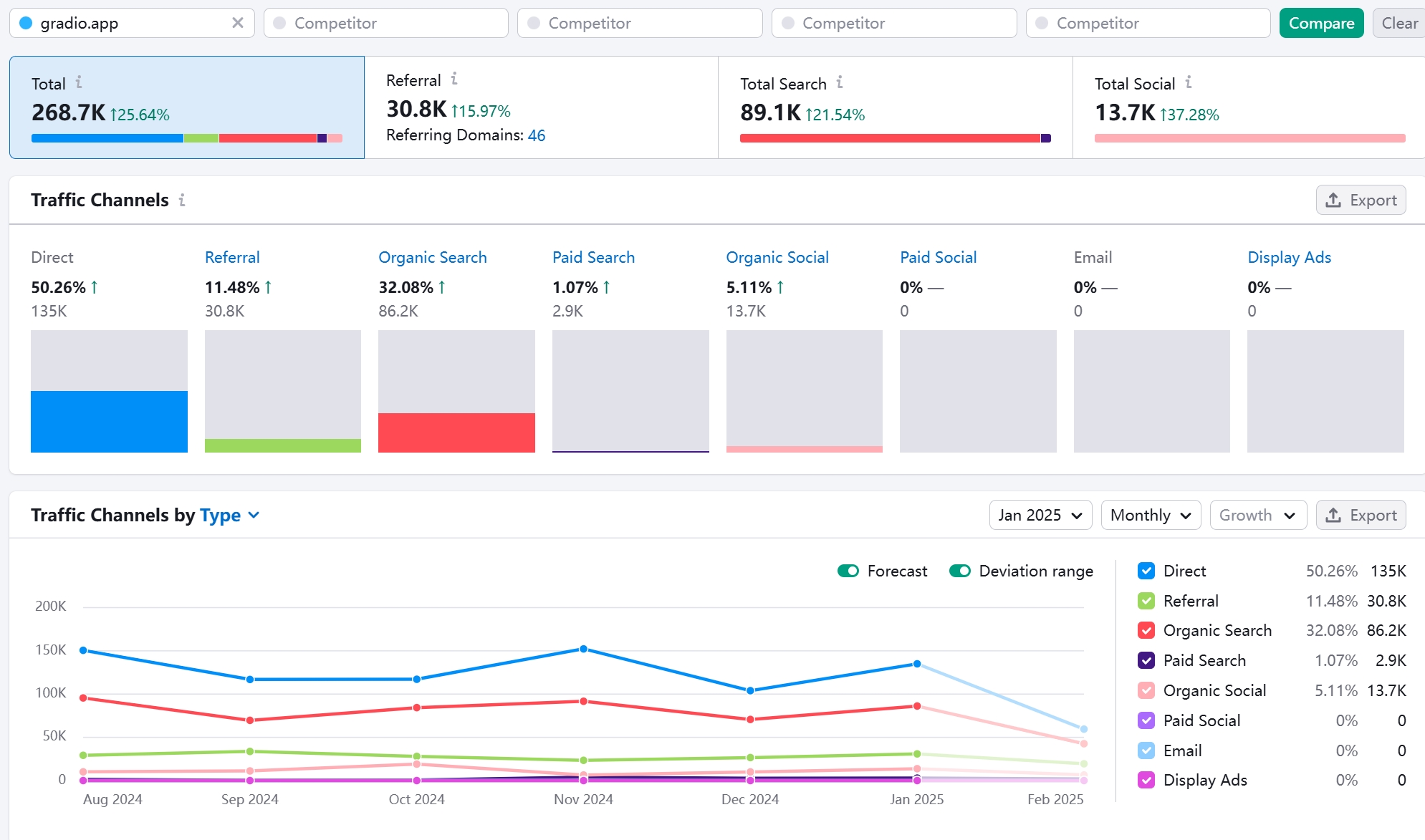
Gradio – Python-based AI Open Source Library
Gradio is a Python-based open source library focused on quickly building interactive user interfaces (UIs) for artificial intelligence (AI) models.Developers can use Gradio to encapsulate a machine learning (ML) model or arbitrary function into a web application and generate a shareable URL. Gradio allows users to demonstrate, test, and rapidly prototype AI models with a few lines of code, without the need for front-end development skills, and is used in a wide range of applications such as academic research, product development, teaching and training, and AI prototype validation.Gradio is widely used in academic research, product development, teaching and training, and AI prototype validation, and is especially suitable for scenarios that require real-time interaction with AI models.
Gradio Overview
Gradio is a Python-based open source library focused on quickly building interactive user interfaces (UIs) for artificial intelligence (AI) models.Developers can use Gradio to encapsulate a machine learning (ML) model or arbitrary function into a web application and generate a shareable URL. Gradio allows users to demonstrate, test, and rapidly prototype AI models with a few lines of code, without the need for front-end development skills, and is used in a wide range of applications such as academic research, product development, teaching and training, and AI prototype validation.Gradio is widely used in academic research, product development, teaching and training, and AI prototype validation, and is especially suitable for scenarios that require real-time interaction with AI models.

Gradio Core Features
- Rapidly Build AI Applications
With Gradio, you can quickly encapsulate a machine learning model into an interactive web interface, and easily build an efficient user interaction channel by simply defining the input components (e.g., textboxes, upload buttons) and output components (e.g., text, images). - Real-Time Reasoning and Results Presentation
Gradio provides fast-response real-time interaction. After the user inputs data, the AI model processes and returns results directly, which is suitable for model performance testing and debugging. - Seamless Integration with Mainstream AI Frameworks
Gradio supports seamless integration with mainstream AI frameworks such as TensorFlow, PyTorch, Hugging Face Transformers, etc., which is suitable for deploying a wide range of AI models from natural language processing to computer vision. - Automatic Generation of Shared Links
Gradio generates a unique public URL for each application created, making it easy for developers to share models with colleagues, customers, or the public for testing and demonstration. - Visualize AI Data Processing
Includes real-time visualization of inputs and outputs, supporting the display of text, images, audio, video, and other data formats to enhance the interpretability and transparency of AI models. - Lightweight and Extensible
Gradio applications are lightweight, do not require complex server deployment, and support the use of other Python libraries, users can also customize the components and interface layout according to their needs.
Gradio Advantages
- Low entry threshold
is very friendly to developers without front-end development experience, only Python can complete the construction of interactive applications. - Highly flexible
Rich input and output components to adapt to the interaction needs of various AI models and functions, as well as support for custom styles and layouts. - Open Source and Active Community
As an open source project, Gradio has an active developer community, where users can participate in development, share experiences, and get community support. - Convenient Cloud Sharing
The automatically generated public URL reduces the sharing cost, and users don't need to configure additional servers or hosting environments. - Compatible with mainstream frameworks
works well with major frameworks in the AI ecosystem (e.g. TensorFlow, PyTorch, etc.), making Gradio an ideal tool for AI model deployment.
Who Gradio is for
- AI Researchers: Facilitate rapid debugging and testing of models, while easily sharing results with your team or the public.
- Data scientists: create interactive interfaces to models for themselves or other users to present or test data analysis results.
- Product managers and developers: Rapidly prototype machine learning products to gather user feedback and optimize models.
- Educators: Use for teaching demos and lab projects to help students visualize how AI models work.
- AI enthusiasts and beginners: deploy and share your own AI modeling projects without complex server configuration.
User Reviews
- Mark
"Gradio is one of my most used tools when developing AI projects!It allows me to quickly test my models while showing the functionality to clients, simply and efficiently." - Emily
"As an educator, I use Gradio to show my students how neural networks work.This tool completely lowers the technical barrier and the student feedback has been great!" - Jason
"I love its URL sharing feature!It's so great for model prototyping to be able to just generate an accessible link without a complicated deployment process."
FAQ
- Does Gradio support offline deployment?
Yes, Gradio runs locally by default and provides a localhost address, but it can also be shared over a network to generate a public URL. for more complex deployments, a cloud environment or server hosting can be used. - Does Gradio support multiple users at the same time?
The generated application supports simultaneous access by multiple users, but the exact concurrency performance depends on the operating environment (e.g. local device or server performance). - Is Gradio suitable for production environments?
Gradio is better suited for rapid prototyping and testing, and while it can be used in production environments, it is recommended that it be deployed in conjunction with other hosted tools such as Flask or FastAPI for optimized deployment of large-scale applications. - Is Gradio compatible with custom components or input/output formats?
Yes, Gradio allows developers to create custom components that allow users to extend the input/output processing logic and interface styles according to their needs.
Other recommended tools like Gradio
- Streamlit
A Python-based open source tool that focuses on quickly building web interfaces for data science and machine learning applications without front-end development skills. - Dash
A web application framework created by Plotly for building data visualization and machine learning applications with high customization support. - Streamlit Cloud
A Streamlit-based hosting service that supports rapid deployment and sharing of data science applications. - Hugging Face Spaces
specializes in the hosting and presentation of machine learning models and integrates perfectly with Gradio for natural language processing and deep learning model presentation. - Flask + HTML/CSS/JS
While requiring some front-end development skills, Flask is a lightweight solution for building more complex web applications.
Gradio Brand Term Search Volume Trends
According to SEMrush, searches for the brand term "Gradio" have been growing steadily over the past year.Especially in the highly active research field of machine learning and AI, Gradio is favored by more and more users due to its rapid deployment capability and user-friendly interface design.

Gradio Website Traffic Trends
Analyzed by SEMrush data, visits to Gradio's official website have increased significantly over the last 6 months, with the main sources of traffic including search engines, tech communities, and social media.In particular, its popularity among the data science and AI developer community is rapidly increasing, indicating that Gradio's user base is still expanding.

Ollama is a platform focused on AI model management and deployment, designed to simplify the process of using and integrating machine learning models.Ollama provides a user-friendly interface that makes it easy for data scientists and developers to manage, run, and share their AI models.